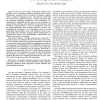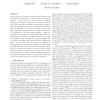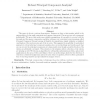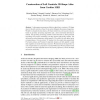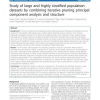111
click to vote
PAMI
2012
12 years 10 months ago
2012
— Over the last century, Component Analysis (CA) methods such as Principal Component Analysis (PCA), Linear Discriminant Analysis (LDA), Canonical Correlation Analysis (CCA), Lap...
ICCV
2011
IEEE
13 years 7 months ago
2011
IEEE
We propose a novel localized principal component analysis (PCA) based curve evolution approach which evolves the segmenting curve semi-locally within various target regions (divis...
SDM
2011
SIAM
13 years 10 months ago
2011
SIAM
Sparse principal component analysis (PCA) imposes extra constraints or penalty terms to the standard PCA to achieve sparsity. In this paper, we first introduce an efficient algor...
JACM
2011
13 years 10 months ago
2011
This paper is about a curious phenomenon. Suppose we have a data matrix, which is the superposition of a low-rank component and a sparse component. Can we recover each component i...
158
click to vote
FIMH
2011
Springer
13 years 11 months ago
2011
Springer
In this paper, we present an effective algorithm to construct a 3D shape atlas for the left ventricle of heart from cardiac Magnetic Resonance Image data. We derive a framework tha...
FGR
2011
IEEE
13 years 11 months ago
2011
IEEE
— We introduce a fast and robust subspace-based approach to appearance-based object tracking. The core of our approach is based on Fast Robust Correlation (FRC), a recently propo...
104
click to vote
CNSR
2011
IEEE
13 years 11 months ago
2011
IEEE
—Principal component based anomaly detection has emerged as an important statistical tool for network anomaly detection. It works by projecting summary network information onto a...
151
click to vote
CNSR
2011
IEEE
13 years 11 months ago
2011
IEEE
—Network delay is a crucial metric for evaluating the state of the network. We present in this paper a structural analysis of network delay, based on delay measurements of a back...
114
click to vote
BMCBI
2011
13 years 11 months ago
2011
Background: The ever increasing sizes of population genetic datasets pose great challenges for population structure analysis. The Tracy-Widom (TW) statistical test is widely used ...
ICASSP
2011
IEEE
13 years 11 months ago
2011
IEEE
There is an increasing number of methods for removing haze and fog from a single image. One of such methods is Dark Channel Prior (DCP). The goal of this paper is to develop a mat...
